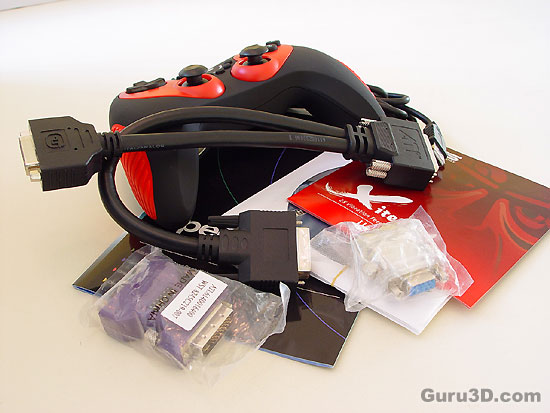Page 3
The ASUS EAX1900XT Crossfire Bundle![]()
What's in the box of that ASUS EAX x1900 Crossfire ? Well it doesn't matter really as you are buying an ASUS product so you'll know for sure you'll receive anything needed to get this puppy up and running in no time, whatever your intention with the card may be. ASUS have included everything you need to setup the card and play a game.
- Software CD with ASUS Splendid software
* ASUS Video Security Online
* ASUS Game LiveShow
* ASUS Game Replay
* ASUS Game FaceMessenger
* ASUS OnScreenDisplay
So what ASUS did not do was to include a game with this bundle. They however did include a rather cool game controller. Nice value for sure. Of course there's also the X1900 XT master card ;) I have nothing much to say other then it's a 100% reference based card which is 'up-to the transistor' similar. I would have loved to see some small changes. The cooler for example is rather noisy and I'd love to have seen that replaced.

Investigating power consumption![]()
The progressively increasing power consumption of computer hardware is really worrying me. I mean, we do have to think of mother earth a little. Next to that we will check a statement that ATI made about power consumption to us. They stated that the X1900 XT would max out at 100-120 Watts. That's similar to NVIDIA's high-end cards.
We simply look at the peak Wattage during a 3DMark05 session to verify those claims. Of course we do what we always do with new graphics cards, we monitor the overall wattage peak with the help of a wattage meter. Slight side note, you are looking at the overall consumption of the PC. The meter is placed between the power connector and the PSU. I understand it's not the most reliable method, but it's a darn good indication !
In 3DMark05 the test platform shows a maximum peak use of 415 Watts for the X1900 XT in Crossfire mode ... that's really a lot but not bad to be honest. Let's have a look at my findings:
100% load
System IdleX1300 XT 193 133X1600 XT 211 140X1800 XL 229 155X1800 XT 273 160X1800 XT (x2 Crossfire) 402 195X1900 XT CF Single 280 165X1900 XTX 290 165X1900 XT (x2 Crossfire) 414 211* Results in Watts
100% load is a 3DMark05 run with the results being published the highest wattage peak (not average). System idle is the PC in 2D mode, the desktop. The cards are clocked faster in 3D mode and also the minute you step from low-end to mid-end to high-end.
